Four butt cracks means four diseased frogs.
“If I only had four frogs.” Is this your horse’s lament?
Pathological frogs are so common, that they have become the norm! Just as long toes and under run heels are normal for Thoroughbreds, sick frogs are nearing normal for most horses. What else do we see in my home state of Delaware where we had an amazing 26″ of rain in August, normally one of two driest months!
If you have not been following my posts in Notes From the Field, I hope you will check them out. The importance of the frog for excellent, barefoot movement is discussed in detail. When you know what a healthy frog looks like, how bad ones heal, along with the various soaks, topical treatments, and tips for, in Pete Ramey‘s words, outrunning thrush, you will have the tools to maintain frog health.
It can be a job, there’s no question about that. Gird your loins and let’s get to it!
For starters, my most common errors in earlier days were:
(A) Not cleaning the area before treatment. (Thank you Linda Cowles!)
(B) Not taking frog health seriously until the horse was ouchy. Then inconsistent treatment.
(C) Stopping treatment too early, only to see the same sick frog in a month.
(D) And ever using Thrush Buster. It contains formaldehyde which kills healthy as well as diseased tissue, according to my chemist friend. Get rid of Thrush Buster!
Just Frogs
- Healthy, functional frogs
- Diseased and unhealthy frogs
- Recovering frogs
- Pick and **clean**
- Treatment Recipes (Thank you Laura Florence, barefoot trimmer and body worker)
- Soaking Recipes (ditto)
- Thoughts on Out Running Thrush
1. Some Healthy Frogs
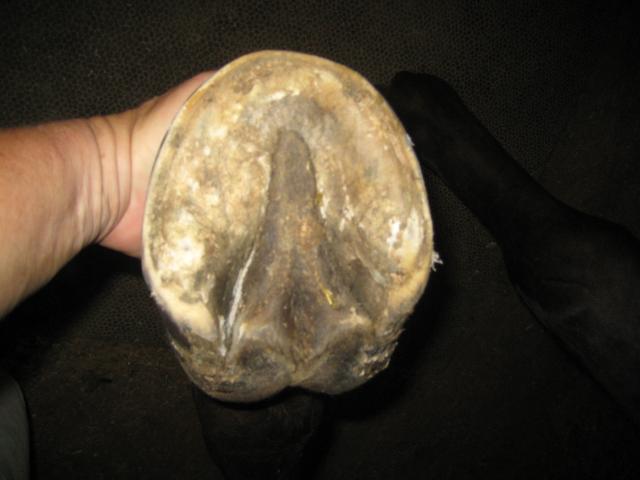
Meet Cadence, a Quarter Horse, on his first trim. Over time his foot became more oval but for this trim, I assumed the frog was where it needed to be, for ideal function. No need to ‘pretty’ things up. The back of the frog is broad and became even broader over time. What a landing pad! The frog’s perfect center, the central sulcus, is a shallow thumbprint. Perfect! The lateral grooves on either side of the frog are about 3/4″ at their deepest and they are dry.
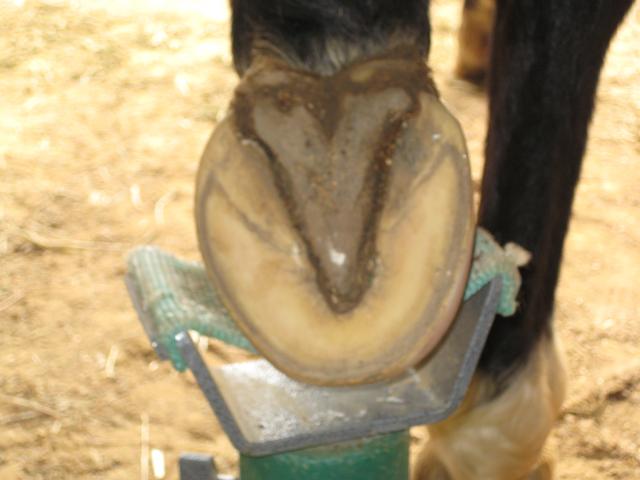
I guess Mason, who hides his Appaloosa spots, wins the prize on this one. BTW his trimmer is his owner, Carlyn. Massive, robust frog allows Mason to land solidly on the back of his foot. Again this was early in his career from bare to better.
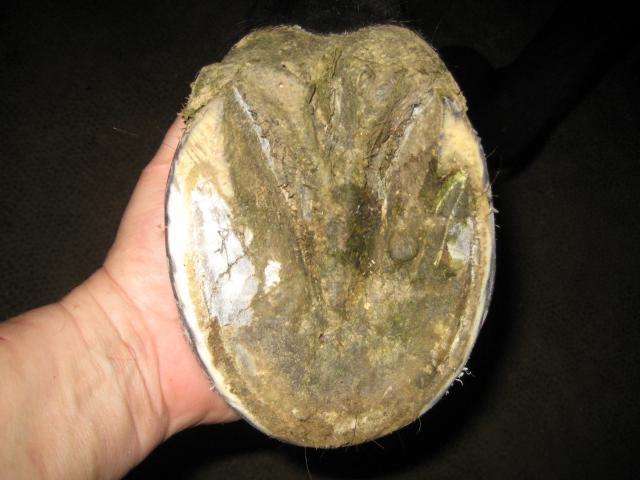
Large pony, Kay, had been barefoot a long time with a pasture trim. Over time, as she grew out her flared wall, her toe shortened significantly. (Knowing more now, I would have brought it back.) Although not as pretty as the preceding frogs, the rear of the frog is wide, the center is free of disease. Looks like some older frog tissue is shedding and new coming in. I didn’t ‘beautify’ it with my knife as there were no nooks or crannies for disease to settle into.
2. Unhealthy Frogs
The most common problem I saw during my years as a professional trimmer, was diseased central sulcus of the frog. It may or may not be sensitive. Doesn’t matter. Butt Cracks are not healthy and should be treated rigorously. Technically many frogs don’t have thrush; but they have something! Whether it’s bacterial or fungal: pick/brush, clean and treat, soak, then outrun it.
The worst frog I ever saw was a puddle of black gooey thrush. The horse was stalled in a Philadelphia ‘city barn’ 22 hours a day and the stall was cleaned once a day. Standing purposely in urine relieved his itchy discomfort. The poor horse would never recover in my view. I suggested the owner relocate her horse to the country and field board him near her home. I gave her a plan for daily treatment. I did make the mistake of investigating the frog with my knife and it began to bleed immediately.
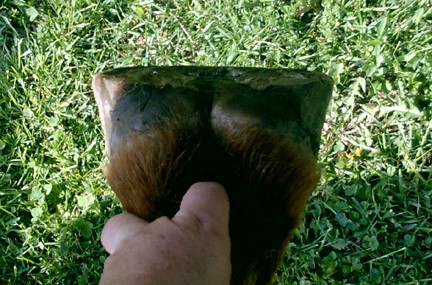
From the back you can clearly see Banjo’s (OTTB, my very first trimming guinea pig) ‘butt crack’ between the heels bulbs. Remember to check the solar (bottom) view of the frog, either side of the frog and the bulbs as viewed here.

From the bottom or solar view, we see Banjo’s pencil thin, deformed frog. It does look like the central sulcus is filling in with healthy tissue. Frog healing and the opening or de-contraction of the heels takes time and patience. Banjo was pasture sound throughout. If I could go back in time, I would have put him in padded Epics with lots of Gold Bond Powder and hit the trails. Sound stimulation helps ‘outrun disease’. I only had a long weekend of training under my apron and the occasional help from the barn’s farrier when I first laid rasp on wall. Even so, Big Band Show was better off out of metal shoes. The improvement in his health was dramatic and almost instantaneous! You go Owner-Trimmers.
(Above) The Healing Frog and Contracted Heels: Banjo’s photo above gives a nice view of heels that are very close together, contracted. They do this to protect the weak frog and above it, the digital cushion. With treatment and lots of sound, heel-first landings a foot like this recovers, every time. The heels start to de-contract when the foot is ready. And internally the digital cushion and lateral cartilages come back to life.
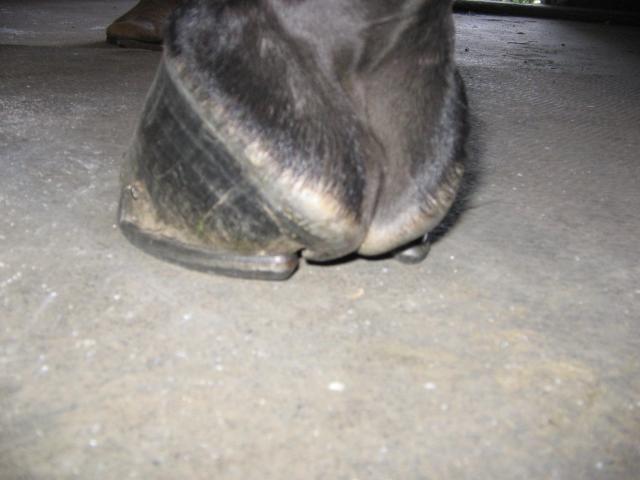 Contracted Heels in Shoes: Just by watching horses pass by, you can tell when shod horses have a weak back of foot. The heels look pinched. The back of the shoe is almost touching. Above the hairline, that bulge pressing up the back of the foot, is the lateral cartilage. It’s 100% non-functional. This is Cayuga, an unraced Thoroughbred at 13, shod most of his life. Sadly I could go in almost any barn where horses are shod and find a variation on this theme.
Contracted Heels in Shoes: Just by watching horses pass by, you can tell when shod horses have a weak back of foot. The heels look pinched. The back of the shoe is almost touching. Above the hairline, that bulge pressing up the back of the foot, is the lateral cartilage. It’s 100% non-functional. This is Cayuga, an unraced Thoroughbred at 13, shod most of his life. Sadly I could go in almost any barn where horses are shod and find a variation on this theme.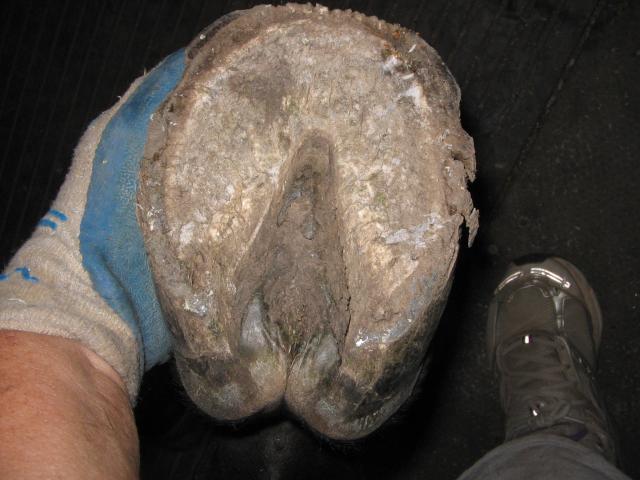
I gingerly removed the shoe, nail by nail. Can you see how pinched the back of the frog is. The heels too are very close together, protecting the back of the foot. It can get worse; the heels can actually touch. This thoroughbred was not lame in or out of shoes. It took a long time to rehab his feet to health and repair his body. Soundness is a ‘whole horse’ issue. I fitted him in Epics with black sole pads and black frog pressure pads, to provide stimulation when ridden. He was ridden right out the barn.
The last time his owner tried barefoot, the horse was lame for 7 months before she gave up. The horse was lamed by aggressive trimming. Great hooves are grown. No need to match someone’s concept of ‘ideal’.
For a horse like this, and sadly my own boy at the moment, the owner must make frog care an essential part of daily rooming. If you must, skip something, do not let it be hoof care. After all, no one died from a crappy looking tail!
3. Close to Recovery
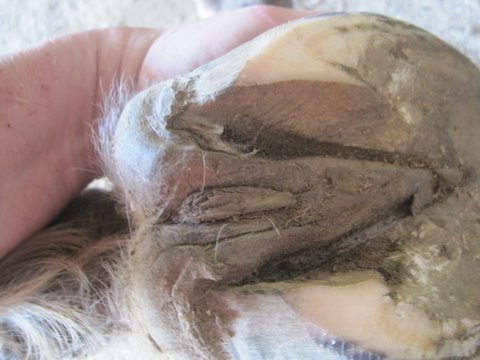 The central sulcus of the frog heals from the inside out.
The central sulcus of the frog heals from the inside out.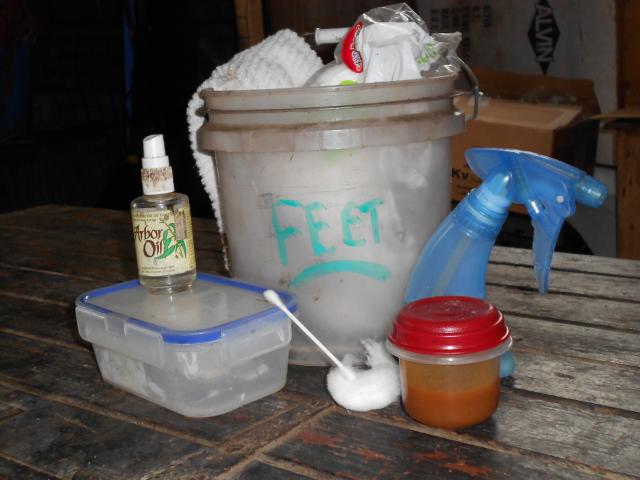
Sunny’s FEET Treatment bucket with all his daily needs: “Goop”, Tea Tree Oil, Manuka Honey, Cotton Balls, Spray Bottle of Dilute Anti-bacterial Soap, Hand Towel and Hoof Pick.
I found that rigorous treatment was much less of a hassle when I finally broke down and got everything I needed and put it in one place, Sunny’s Feet bucket. Note: Check with your vet on specifics on any of the recommended treatments or other ones you might find at the tack shop or on-line. The ‘natural’ claim doesn’t always mean good.
First, do no harm. If your horse flinches during care, find another pain-free way to work. Twice now, I have been hired to trim horses who kicked farriers because of previous rough and painful treatment by hoof pro, owner or vets. It took me one or just a few visits to gain the horses’ trust using clicker training. Why traumatize the horses we love?
4. The Basics for Daily Cleaning
- Hoof pick with brush. Hand towels.
- Scrub brush, bucket and anti bacterial soap like Dawn dish detergent diluted or,
- Fill a spray bottle with same or,
- Fill a wormer tube or syringe with same.
- All antiseptic liquids are diluted: Dawn, Lysol, etc.
I wouldn’t treat my own deep cut without washing it first. Well same goes for my horse. Obviously scrubbing four feet (why not do all four since you are down there?) is much easier if you have a wash stall. Since I don’t, I first tried filling up wormer tubes or syringes and irrigating the frog crevices with anti-bacterial soap, Dawn of course. But refilling was a hassle. I switched to a spray bottle and a small towel to ‘floss’ the area clean. I mixed a milk jug of cleaner for quick refills.
If the central sulcus were more like a deep crevice, I would certainly use the thin tipped syringes in addition to irrigate the wound. Q tips are handy too.

Medium pony lame in shoes. The central sulcus was 1.5″ deep. First steps were to get her out of shoes, out of the stall and into a daily treatment regimen.

Her young owner could ride the pony in Epics with green pads.
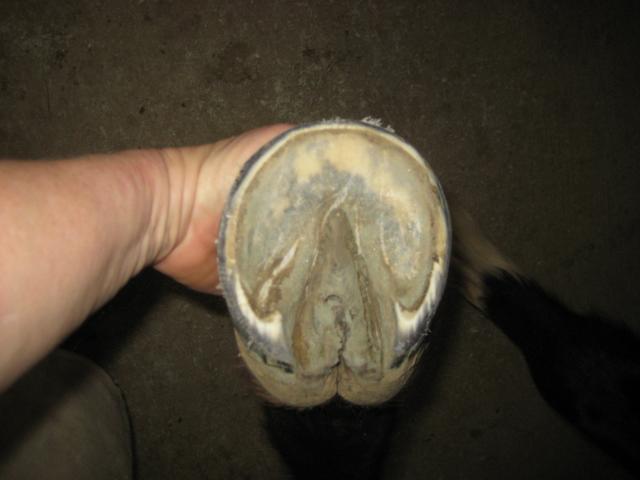
One month later, the heels are de-contracting a bit. The central sulcus isn’t as deep. Full healing just takes time and diligent treatment.
- Make your own Pete’s Goop: 50% antibiotic cream and 50% anti fungal cream in syringe.
- Purchase cow mastitis treatment like ToDay (12 syringes in a box), available on-line or at Tractor Supply. Recycle the syringes for Goop above or irrigation tool.
- Tea Tree Oil from the health food store. Mine comes in a handy spray (onto cotton) bottle.
- Mashed Garlic is anti-bacterial and comes in a jar. Check your grocery store.
- Calendula Cream (Thanks again to Laura Florence, barefoot trimmer) from the health store.
- Raw Honey wax free. No Smirks! Honestly! It’s used on, among other things, human burn victims.
- Or even better but more expensive (unless you’re a kiwi), Manuka Honey from New Zealand. It has many uses, including repairing wrinkles! (I’ll get back to you on that).
- Cotton balls from the pharmacy. Q-tips are nice but not essential.
For Pete’s goop and the others above, I have found 2 methods of application.
(A) The more time consuming one is to mix the 2 creams well. Then stuff into a fat wormer tube and then inject into an Exel 12 cc curved tip syringe. Perfect for deep crevices. Pull apart one cotton ball so there are no painful lumps and gently pack, using hoof pick, into the central sulcus.
(B) When the crevice isn’t that deep, I dip the half cotton ball into the Goop or Honey and stuff it into the frog with a hoof pick. This eliminates the syringe filling step which is harder than you would think.
When I can no longer stuff a cotton ball in the sulcus, I spray Tea Tree Oil until 100% healthy.
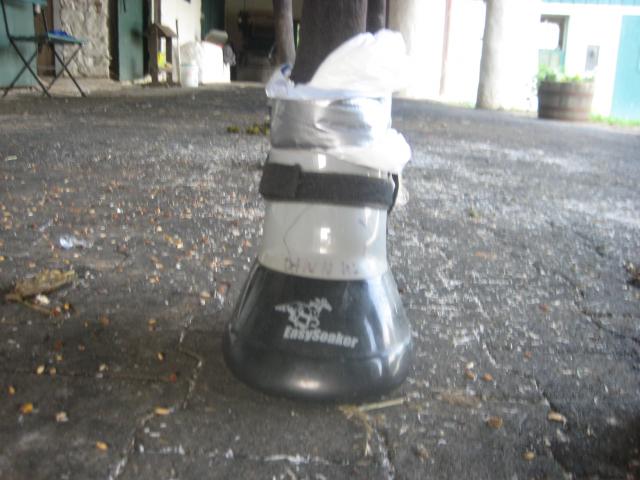 Bagged and booted for a soak in White Lightening.
Bagged and booted for a soak in White Lightening.6. The Basics for Soaking and Irrigating (Thanks to Laura Florence my favorite barefoot trimmer)
If frogs are particularly bad or you simply have the time, soaking the feet is a great idea to create an environment hostile to bad bugs. I soak once a week when treating frogs. I set Sunny up in his otherwise unused stall with some extra good hay and a fan. I hang out on a straw bale with a horse book. OK, honestly he makes me dip his hay in water and hand feed him. When he’s full, we take our naps.
Soaks, alternate or use your favorite:
- Easy Care Soaking Boots
- White Lightening and White Vinegar. I use 1/8th cup of each.
- If using above, sturdy waste bags and duct tape to fully enclose foot and capture gases.
- Or 50% Apple Cider Vinegar with 50% water
- Or 10% Bleach and 90% water
- Or 1-2 Tablespoons of Lysol with water
- Or some Borax dissolved in water
According to the techs at Grand Circuit Products, makers of White Lightening, you can soak as often as every other day with White Lightening. The dilution is active for 8 hours. If you are short on funds but long on time, you may rotate one boot, 30 minutes a foot, to all feet. The foot must be bagged to capture the gases that provide a deep penetrating soak. I will use it on an abscess, cracks, etc. It’s available online or at the farrier supply store. They recommend 1/4 cup but I think that’s excessive since it’s the gases that do the trick. Gases are released when you combine White Lightening and Vinegar. You can add the same amount of water to increase volume.
The rest of the soaks require soaking boots or buckets if your horse is quiet.
I generally irrigate the frog with the soaking material in a syringe after removing the boot.
Additionally:
- Q tips for cleaning frog crevice.
- Gold Bond Powder for riding boots to keep the foot dry in many conditions and again, create an environment hostel to bugs.
- I generally do not recommend the RX boot or Equicast because I don’t want to enclose the foot.
- Thrush Buster has formaldehyde. It kills healthy and unhealthy tissue!
- Dr. Bowker once recommended leaving dirt in the collateral grooves on either side of the frog as it may have a role in hoof mechanics. But for my environment, it’s just not practical or healthy.
- The Horse’s Hoof has an excellent series on hoof treatment.
Whether in field turnout, in-hand, being ponied or mounted, sound movement heals.
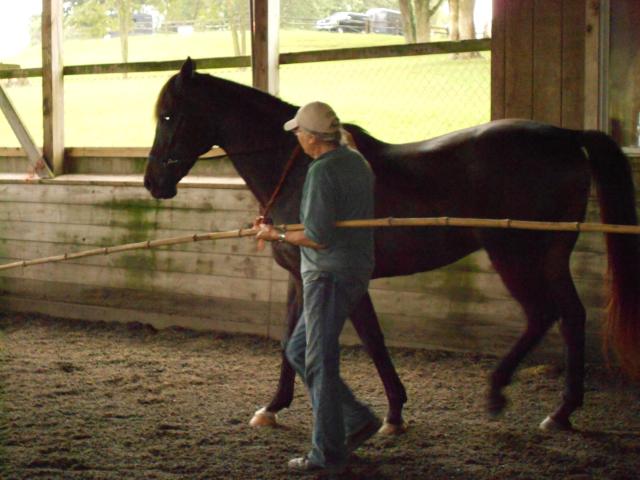 Jill Wilcox (80 yrs) work ‘in-hand’ with Runner (OTTB) at the walk. Working along the wall with a pole encourages, first straightness and then balance. She will progress to trot and canter in-hand. All her students work in-hand before mounting. (Note she uses reins attached to nose band, no bit and a neck band.) It’s much easier for the horse to move correctly without the rider.
Jill Wilcox (80 yrs) work ‘in-hand’ with Runner (OTTB) at the walk. Working along the wall with a pole encourages, first straightness and then balance. She will progress to trot and canter in-hand. All her students work in-hand before mounting. (Note she uses reins attached to nose band, no bit and a neck band.) It’s much easier for the horse to move correctly without the rider.7. Out Running Thrush or Bacterial Infections
The first time I heard the phrase, out running thrush, at a clinic, I hadn’t a clue to the meaning. I have learned the hard way that we have to grow healthy tissue faster than the bad bugs inflict damage. Simply treating a stalled horse, for instance, might not be adequate. One of our Barefoot Mantras: Sound Movement Heals.
If your horse is sound in padded boots, ride him, even if it’s just at walk. If not, consider ‘ponying’ him, again in padded boots, off another horse. Turn him out with a busy herd or a nasty pony. No standing around in sheds with manure floors. No shoes. No stalling. If you are boarding in a mud hole, leave.
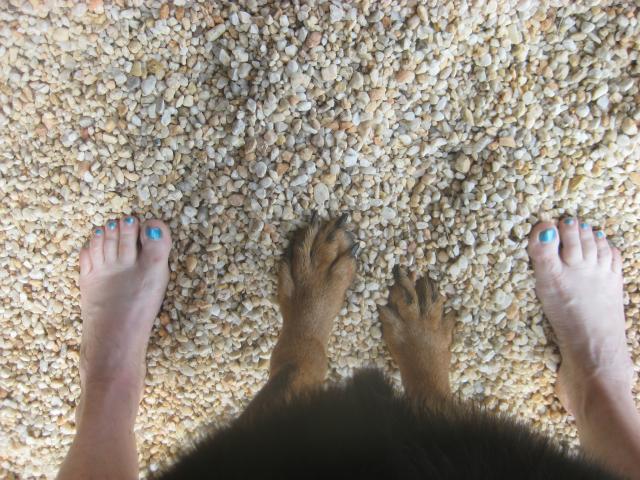 Pea Gravel feels good, even to the sorest horse. It offers just the perfect amount of stimulation.
Pea Gravel feels good, even to the sorest horse. It offers just the perfect amount of stimulation.I have seen some farms where you just can’t avoid a rocky path to the pasture. Consider covering it with cut up stall mats for your sore pony. Better yet, dig it up, add some landscaping material and fill with 4″ of pea gravel. Add pea gravel to the loafing areas. It’s a miracle cure that Dr. Robert Bowker has discussed in a published work. Make a copy for the owner if you board.
As for the trim, leave a little heel so the frog can get just the right stimulation to grow, but adequate protection. Once you’ve got a nice frog, those heels will come right down, where they want to be.
I’ll trim the frog to remove flaps and hide-y-holes for disease. Beyond that, all I can say is think before you cut or snip. Removing diseased frog can be tricky. If you trim a sick frog and it bleeds, your horse is now open to infection. Cutting open the central sulcus to let the air in often lames the horse which in my view is abusive. I move cautiously and respectfully.
As you can see, I have become a passionate student of the frog! Most of the lessons were learned the hard way. I hope this helped you. Feel free to share and post at your barn.
Happy Trails,
Dawn
P.S. Find more good reading and free trimming videos go to my site 4sweetfeet.com
P.P.S. For my next post look for Clicker Training Your Horse During the Inevitable Down Time, December.





